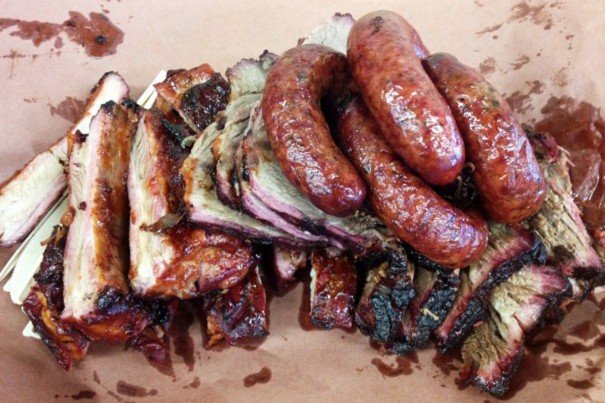
The Year in Food

From seared horse steak to contentious chili sauce to a bowl of perfect sardine-laced pasta, the plates that shaped the first year of Roads & Kingdoms.
The world reveals itself to us one bite at a time. Want to better understand the explosive relationship between Georgia and Abkhazia? Swirl a bit of adjika into your next beef stew. Trying to get a grasp on the complexities of Chile and Peru’s shared political history? Drink a pisco sour. Looking to see how American culture has impacted the lifestyle of Mexican immigrants? Order a carne asada super burrito and loosen your belt buckle.
By that measure, we’ve covered quite a bit of ground in 2012, from the barbecue pits of Lockhart, Texas to the ice cream parlors of Mogadishu. Many tasty dishes have been consumed along the way, but deliciousness isn’t always the measuring stick when we talk about the meals that matter most.
To better understand the people and the places we’ve come to know this past year, we’ve compiled a list of the most memorable meals from 2012. These aren’t necessarily the best things we ate, but these dishes tell important stories about the people who dedicate their lives to feeding others, about regions that give birth to remarkable convergences of taste, texture and circumstance, and about a little online magazine taking shape one bite at a time.

26-Course Tasting Menu at Noma
Copenhagen, Denmark
We won the restaurant lottery earlier this year when, through a stroke of divine intervention, we scored a reservation to Noma, three-time holder of the “Best Restaurant in the World” title. The five-hour feast was filled with enough memorable dishes to justify many thousands of words of praise (4,679 words, to be exact), but the snacks portion of the dinner, when tiny, concentrated bites of extraordinary precision come flying out of the kitchen at a breathless clip, was easily the most exhilarating 30 minutes of eating I’ve ever experienced.
Our table is flooded like some great Southern family picnic. You can’t drop a fork without landing on something smoked or cured or pickled. “What happens when you go to a nice restaurant?” Orlando explains later. “You sit down and the waiter comes and asks ‘Do you want this? Do you want that?’ Then you sit there and you wait for 15 minutes for something to happen. If something doesn’t grab onto you right away, then you lose interest. That’s why we just hit you. It’s our way of saying ‘this is not going to be a boring meal.’”
And so the first half hour flashes by in what feels like seconds. After the featherweight food of the first few courses, the flavors begin to match the pace—intensely crunchy, salty, smoky, sharp bites, one after the next.
A crescent moon of crispy pork skin dusted in pine powder and topped with a black currant fruit leather. (Think: stoner meets late-night convenience store, brilliance ensues.)
A finger sandwich, a tile of rye bread filled with lumpfish roe, dill, and smoked cream cheese, and topped with crispy chicken skin. (Think: everything bagel meets chicken nugget, brilliance ensues.)
Cod liver, brined, smoked, frozen, and shaved, dusted with kelp salt, then stacked in a slowly-melting curls atop a milk crisp. (Think: umami madness)
Flower pot. Radish. Dirt. Dig up, crunch down: malt, hazelnuts, dark beer. Grass and yogurt.
Veal neck, hand-shredded into a million microfilaments and wrapped around a spoonful of crème fraiche. Seaweed: oil and powder. A crunchy, creamy marvel. Somewhere upstairs a young prep cook’s fingers are bleeding.
A crunchy wave paved with smoked cod roe, dotted with microherbs and topped with broken shingles of brown glass. Those shards are duck chips, not made from the meat itself, but from intensely reduced duck stock, skimmed like warm milk, then crisped up on the flattop. If this bite of food doesn’t give you goose bumps, you’re a stone-cold motherfucker.
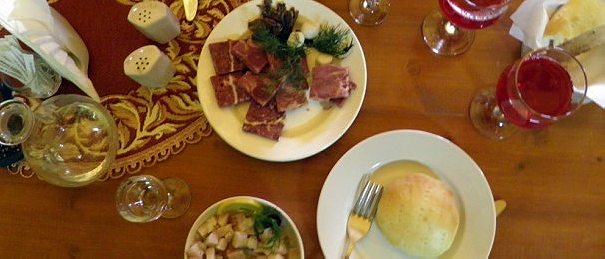
Horse steak
Yakutsk, Russia
Ilan Greenberg traveled to Yakutsk in the upper reaches of Siberia, one of the coldest cities on the planet, where -40˚F weather has birthed a diet short on vegetables and long on fat and protein. After a moveable feast of colt carpaccio, raw horse liver, reindeer stir-fry and icy curls of frozen fish, Greenberg finds the Yakuts meal of his dreams:
The cousin took us into the kitchen to show us the gigantic slab of horsemeat steak. The preparation would be severe: no seasoning at all, not a drop of oil or butter; just meat cooked for exactly –“very, very precisely,” the cousin insisted—two minutes in a bone-dry cast iron skillet at a very high heat.
We sat at the kitchen table, each had a goblet of expensive French Bordeaux purchased at a duty free store and a glass of kumus, fermented milk that the cousin had made from a batch of culture he had brought from Kyrgyzstan. With stupendous flourish he turned on the flame and, slightly bent toward the stove, watched the meat heat in the dry skillet for two minutes. And then, for at least another fifteen minutes. Basil and I looked at each other. The smell of burning flesh permeated the small kitchen. Stabbing the meat with a carving knife, he served us.
It was, without a doubt, exquisite. Tender and moist, the steak soared into a stratospheric perfect. Crusted on the edges with a ravishing burn, the pink inside jangled my taste buds ecstatically. I looked over at Basil. He raised one eyebrow; brick-red juice was swimming down his mouth.
It was the most delicious meal we shared.
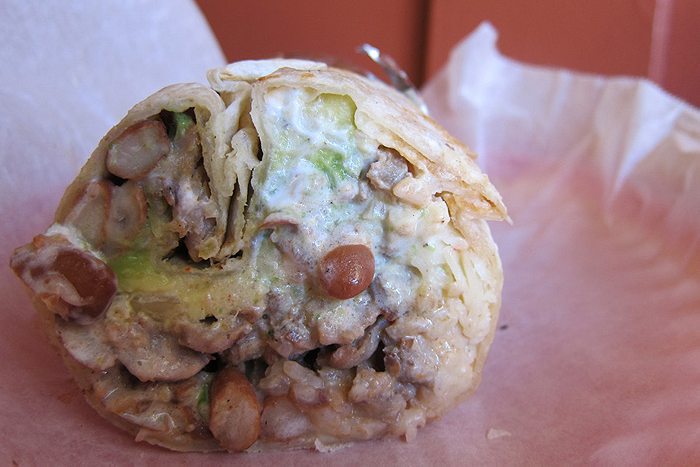
Carne Asada Super Burrito
El Farolito, San Francisco
Like all sensible Californians, half my motivation for returning to my home state involves consuming dangerous quantities of Cali-Mex food—above all, hulking carne asada burritos. The best can be found amidst the dizzying biosphere of taquerías in San Francisco’s Mission District. Of the nearly 100 burrito dispensaries in the neighborhood, the king remains El Farolito, a place neither entirely Mexican nor American, but completely Californian.
Farolito is a place where hangovers go to die, a dark, loud, balmy sliver of a restaurant on Mission just off 24th Street that serves food well into the small hours of the morning. The chips are lousy, the salsa is timid, but goddamn do those guys know how to put out a fine burrito.
Farolito’s version weighs in at just under two pounds. The tortilla, about the size of a manhole cover, is first gently coaxed into pliability on the griddle, then layered with great mounds of pinto beans and orange rice, avocado and sour cream, cheese, salsa, and, of course, about eight ounces of finely chopped carne asada.
It lands with a thud on your table, a warm package wrapped tight in shiny foil. You peel it back like a present and for one brief moment it feels like Christmas has come early. There is nothing subtle about the food before you. You won’t think about how the char of the beef plays beautifully off the heat of the salsa and the acidity of the sour cream. In fact, if your tasting notes move much beyond “holy shit”, you’re trying too hard.
If the taco is about the union of warm corn and savory meat, the burrito is about the fellowship of fat, salt and refined carbohydrates. It drips and oozes, gasps and groans, and slowly buckles and unravels under its own weight. By the time you peel back that last inch of foil, it’s gathered itself into a shapeless mass of beef fat and bean paste and salsa detritus. It’s not uncommon to hear slurping at the end of an El Farolito Super.
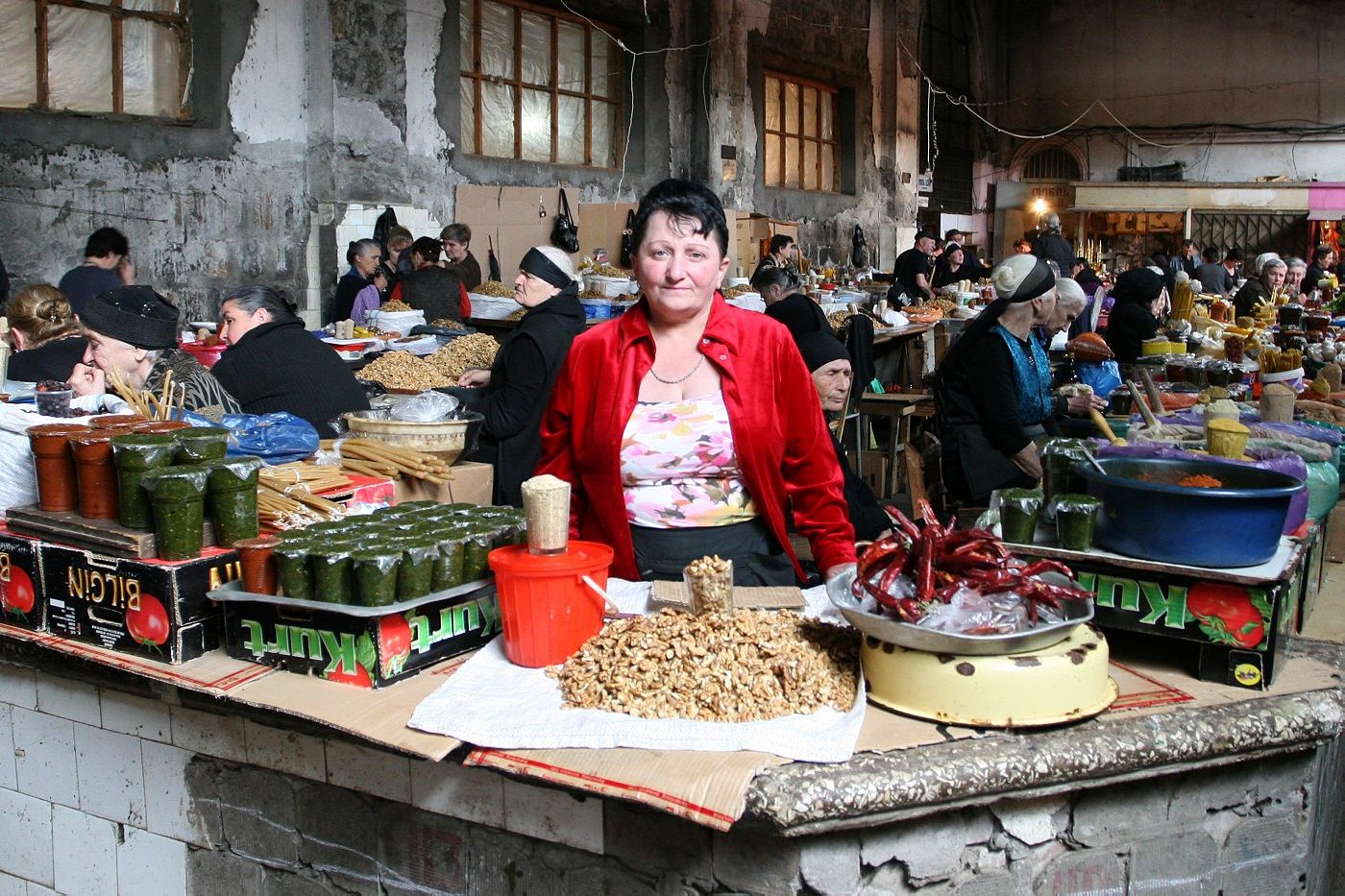
Adjika
Central market, Sukhum, Abkhazia
Oliver Bullough, one of the great chroniclers of the Caucasus, set off our fiercest food fight of the year when he offered up his ode to adjika, a chili-garlic sauce claimed by both Georgia and Abkhazia, contentious neighbors with a deep, patriotic love for this fiery condiment. After angry commenters cried foul, Bullough trekked across the border to try the Georgian version of adjika in a follow-up report, but it was his time in Abkhazia, including a condiment-heavy conversation with President Alexander Ankvab, that won us over.
The market was a chaotic noisy place full of vegetables and bread and furniture and clothes and hustlers. I smiled at the thought of Chirikba, careful and precise in his beautiful suit, walking through here.
But he was right: everyone knew Seda, who was pleasingly nonchalant about having her produce recommended by the country’s top foreign policy official.
“Of course, mine is the best,” she said, pulling out a jar from under a counter covered in vegetables. “It is the purest so it is the best.”
She opened the jar and offered me a spoonful to try. More coriander in this one, I thought, as I waited for the garlic and chilli explosion at the back of my mouth. And something else in there too: dill seeds? Cumin? It was indeed wonderful.
She just smiled at my questions though: “I will not tell anyone anything about what’s in here”.
A bald man, 40 years old or so, was listening to our conversation and chipped in to support Seda’s boast. When he heard I was writing about the national sauce, he insisted on his viewpoint being recorded as well.
“Write that Adjika is Abkhaz, not Georgian. They say it is theirs, but they lie. They always lie,” he said, before stumping off, a string bag of vegetables in each hand.
The Georgians, of course, have their own thoughts on this. But since the word Adjika comes from the Abkhaz word for salt, I am a believer in Abkhaz claims to the invention of it.
Seda dipped the jar in spices to seal it, screwed on the lid, and handed it over.
“Everyone knows me,” she said. “Seda, Seda, Seda, in America, in Israel, auntie Seda, they call me. Auntie Seda.com for adjika. Ha!”
There is, alas, no website. I checked.
With the jar safe in my bag, plus one from her blonde neighbour too, I headed off to see President Alexander Ankvab. We did cover the issues I wanted to discuss—American opposition to Abkhazian independence, Russian support, the return of Georgian refugees. But it was perhaps inevitable we would spend some of our time talking about a particular spicy condiment.
“Adjika is number one,” he said with finality, when I asked him to rank it in the world top 10 of sauces. “I can remember, when I was a schoolboy, when we went to the village, the old women would grind the adjika on a stone like this.”
I looked on in amazement. I had somehow provoked the president of a war-torn semi-recognised country into miming the action of grinding spices on a stone. He had a glint in his eye too.
“There were so many herbs in it, starting with garlic and ending God knows where, but the taste was heavenly. The most tasty kind was done like this, with a stone.”

Causa Limeña
Canta Ranita, Lima, Peru
We’ve been known to occasionally indulge in foodporn on these pages, giving centerfold coverage to dishes otherwise disconnected from social, historical, or cultural contexts that might give them a loftier sense of being in the edible universe. The most brazen smut peddling we did all year came from a tiny restaurant stall in the El Capullo Market in Lima, where a young cook constructs this monolithic masterpiece.
The gorgeous heap before you is called causa, or sometimes causa limeña, in a nod to the dish’s popularity in the Peruvian capital. Unlike Peru’s most famous dish, ceviche, there is nothing vaguely light or refreshing about this tower of power. Causa comes in an impressive number of iterations served up at a vast ecosystem of high-end restaurants, market stalls, and surf shacks, but the thread that holds them all together is three-fold: mashed potatoes, avocado, and mayonnaise—a triple-cream explosion of monotextural extremity.
Within those generous parameters, of course, there is plenty of room for personalization. Peruvian cooks treat causas the same way short-order cooks at Waffle House treat hash browns: scattered (with herbs, onions, chilies), smothered (in salsa de ají, key lime juice, mountain cheese), covered (in octopus tentacles, baby shrimp, shredded duck), and topped (with olives, hard-boiled eggs, raw peppers).
We were shooting video when this tower came together. As Vicente Furgiuele, the fast-talking Peruvian-Argentine owner and cook at Canta Ranita in El Capullo market in Barranco, went about forming those yellow-fleshed potatoes into hockey pucks, spiking the mayo with lime juice, layering the snapper nuggets (coated in oyster sauce before frying—a nod to the deep Asian influence on Lima’s cuisine), building that causa ever higher, Nathan and I had to cover our mouths to stifle the tide of laughter evoked by this incredible display of excess.
Of course, when beers were poured and forks placed before us, the plate was scraped to within an inch of its life. Moral or not, Roads & Kingdoms is down for the causa.
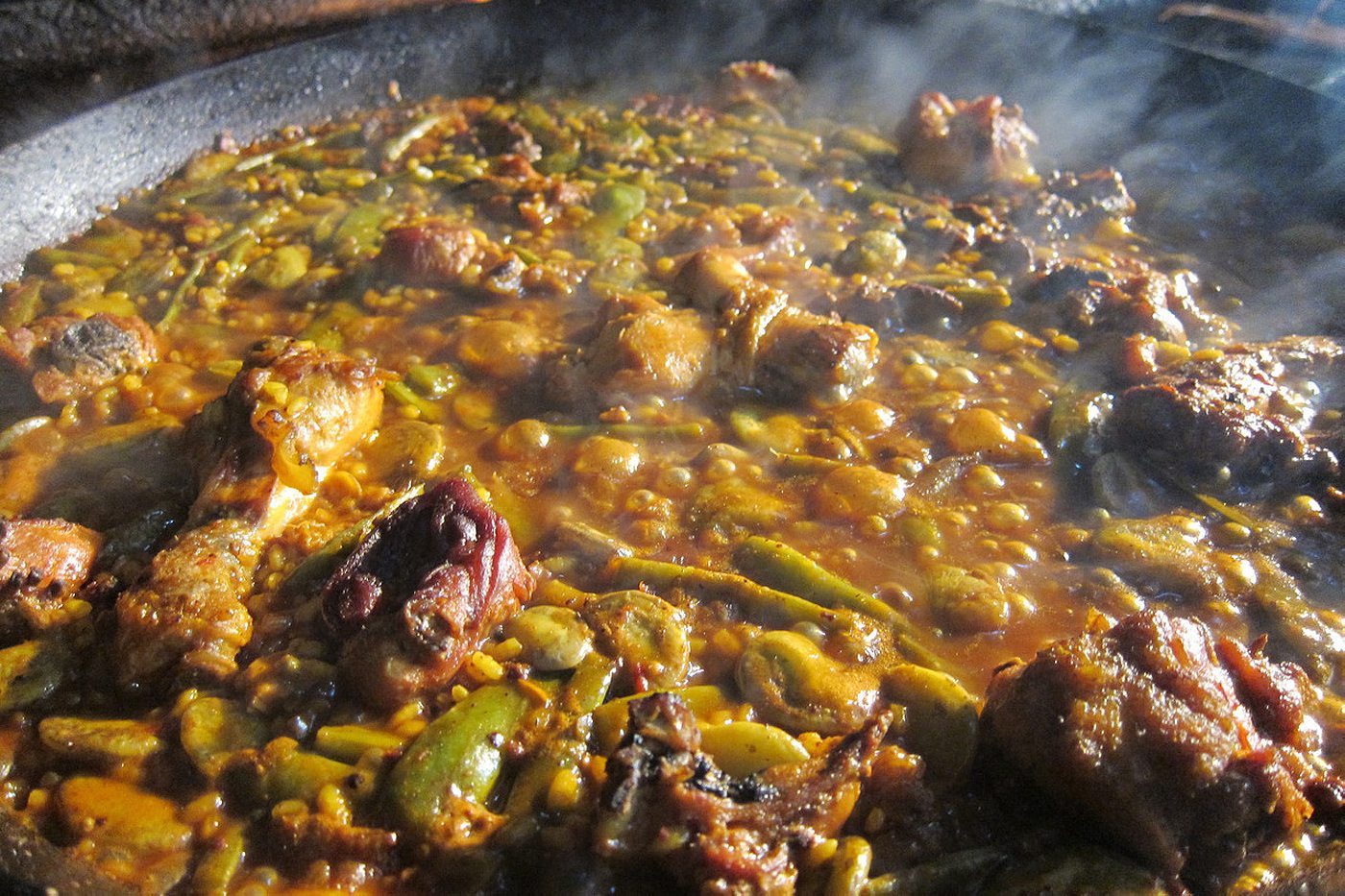
Paella Valenciana
Restaurante Levante, Benissanó, Spain
My life had been filled with one paella disappointment after the next, a soupy, soggy string of underwhelming rice masquerading as the country’s most famous culinary staple. I began to doubt whether anyone in Spain knew how to make paella, until one glorious afternoon, in the tiny town of Benissanó, I met Rafael Vidal, a man who has dedicated his entire life to one dish.
“We cook the paella over two heats—at first very hot, encouraging evaporation, then we pull of some branches so it can finish over a lower flame.” Rafael uses wood from Valencia’s orange groves, just as paella has been made for centuries. The rabbit and chicken he sources locally, the beans—a mix of wide green beans and garrafó, a small white legume similar to lima beans—he grows in the family garden.
The paella, he explains, needs to rest for five minutes before eating—enough for any residual moisture to be absorbed by the rice. Then it travels downstairs via a dumbwaiter before being presented in the dining room. After taking in the sights and smells from Levante’s kitchen, these five minutes stretch well beyond the limits of my patience.
But what’s five minutes after 10 years of confusion and disappointment? There have been some tasty rice dishes along the way, but nothing that ever stuck, ever wobbled the needle of the Richter scale, no bite that ever screamed “this is why people come to Spain in search of this dish.”
Nothing that ever tasted like the plate of rice before me. Levante’s rice is suffused with the sweet smoke of the orange branches. Every grain is swollen into meaty pearls that glisten with sofrito and rendered chicken fat, all while retaining the most gentle resistance. The savory notes of the caramelized meat and vegetables saturate every last grain of rice, yet never threaten to lose their own identity in the dish.
Rafael’s paella contains just 12 ingredients, but tastes as if all of Valencia has been simmered into this paella.
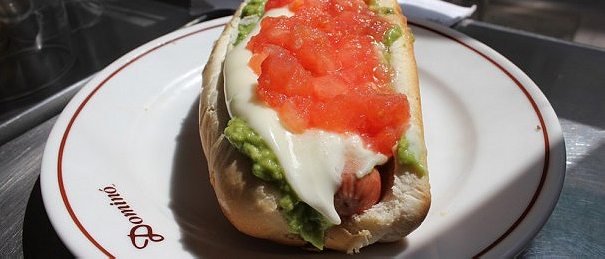
Completo
Dominó, Santiago, Chile
Carolina Miranda risked life and limb in a series of fearless food dispatches from South America, reporting on tamale sandwiches, psychedelic candy apples, and, most enticingly of all, Chile’s formidable contribution to the encased meats canon, el completo.
Take a hot dog. Smother it in mashed avocados and a fistful of chopped tomatoes. Add geologic layers of sauerkraut, sliced green chilies, chopped onions with parsley, and a viscous, vinegary mix of finely minced pickled cucumbers and carrots. Then dress with ketchup, mustard and a pillow of puffy artisanal mayonnaise. This otherworldly behemoth is known as the completo (as in: “complete”) and it is a staple in Chile, where cafés, bistros, fast food outlets, mall food courts and home cooks all produce some version of it, adding signature flourishes such as scrambled eggs, sautéed onions, melted cheese, crumbled bacon and various sauces, hot and otherwise.
In a country renowned for its low-key, downright conservative demeanor, the completo proves that there is a well of insanity lying just beneath the surface — a decadent subconscious poking holes in all that well-mannered Catholic morality. Put this hot dog into your mouth for the very first time, and you may feel as if you’ve been deflowered. It is a sublime combination of grease and citric tartness, squishy avocado and crunchy onions, snappy meat and hearty bun. Once you’ve had it, there is no going back to the pedestrian combination of ketchup and mustard.
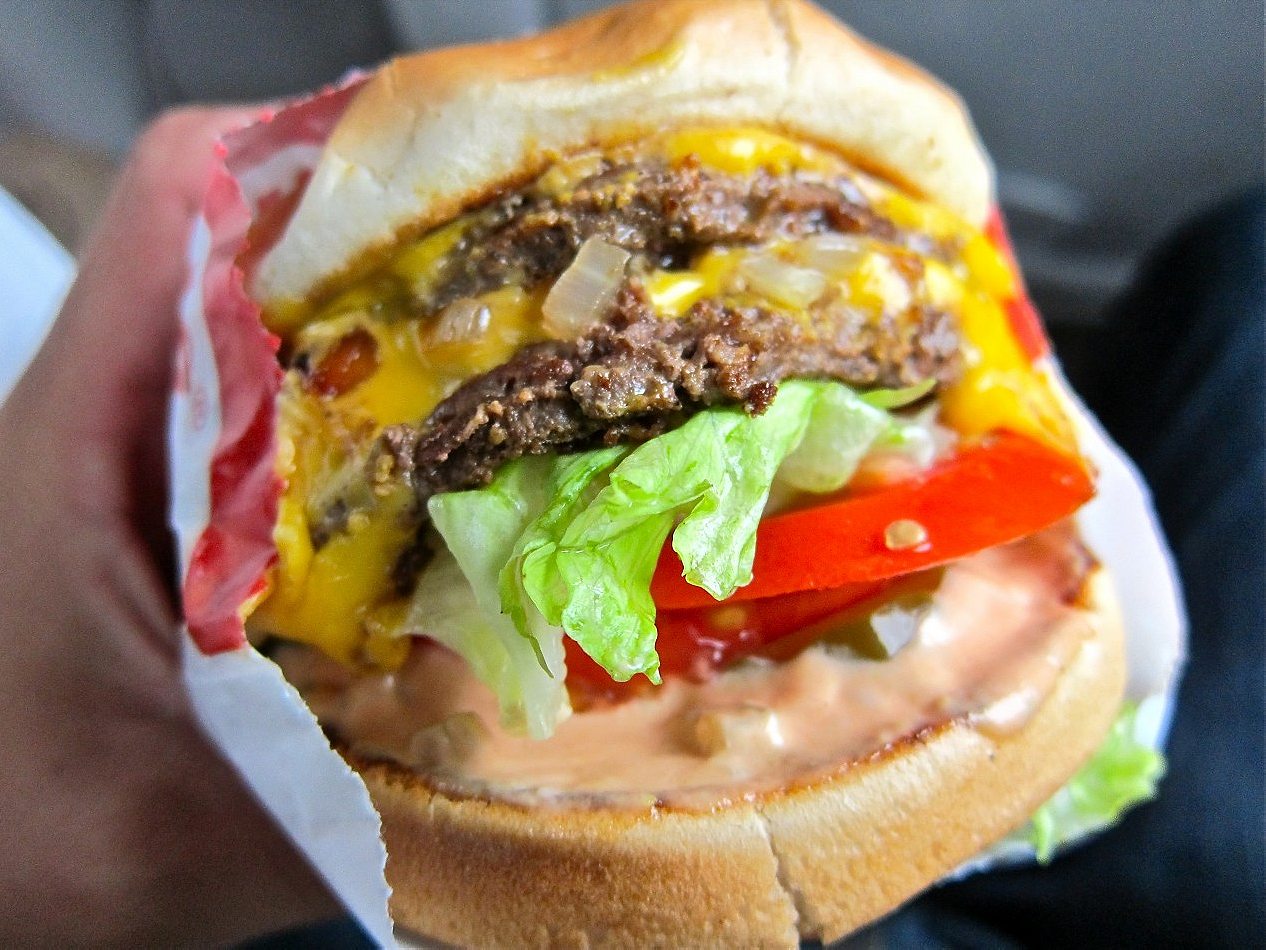
Double-Double Animal Style
In-N-Out, San Diego, California
My love affair with this West Coast icon knows no limits. In a year of prodigious patty consumption, from the $26 Minetta Tavern Black Label Burger in New York to Barcelona’s beloved Kiosko behemoths to an ostrich burger slathered in roasted beets in Cape Town, it is still the Double-Double that stands above the rest as the burger benchmark.
My first memories of the Double-Double begin on that long, bleak stretch of California asphalt known as Highway 5, a strip of diabolical pavement whose eye-gouging monotony is interrupted just twice in the 400 miles between San Francisco and Los Angeles, first by the cow-fart factories surrounding Harris Ranch, and second by the Grapevine, the mountain gateway to Southern California, a muscular announcement that meant In-N-Out was near. My family measured the distance between the Bay Area and LA with our noses: first there was methane, later the funk of rendered beef fat. (Only later did I learn that Harris Ranch is in fact one of In-N-Out’s largest beef suppliers…the circle of life.) With only boiled ham and a grandmother’s love waiting for me on the other end of the drive-thru, those cheeseburger pit stops were my first moments of joy on the road.
There are many things that make this burger so special to so many: the potato bun, squishy on top, griddle-crisped around the edges underneath, the sweet-savory warmth of onions caramelized in beef fat, the ideal burger-to-condiment ratio carried out with produce that is way better than it needs to be (I mean, look at those tomatoes! Prostitutes the world over would kill to have lipstick that red.) The way the cheese melts into the wrapper and when you think no one is looking you start nibbling away at the grease-soaked paper and you’re loving every second of it until suddenly it dawns on you that this burger, this fucking burger, has driven you to eat paper.
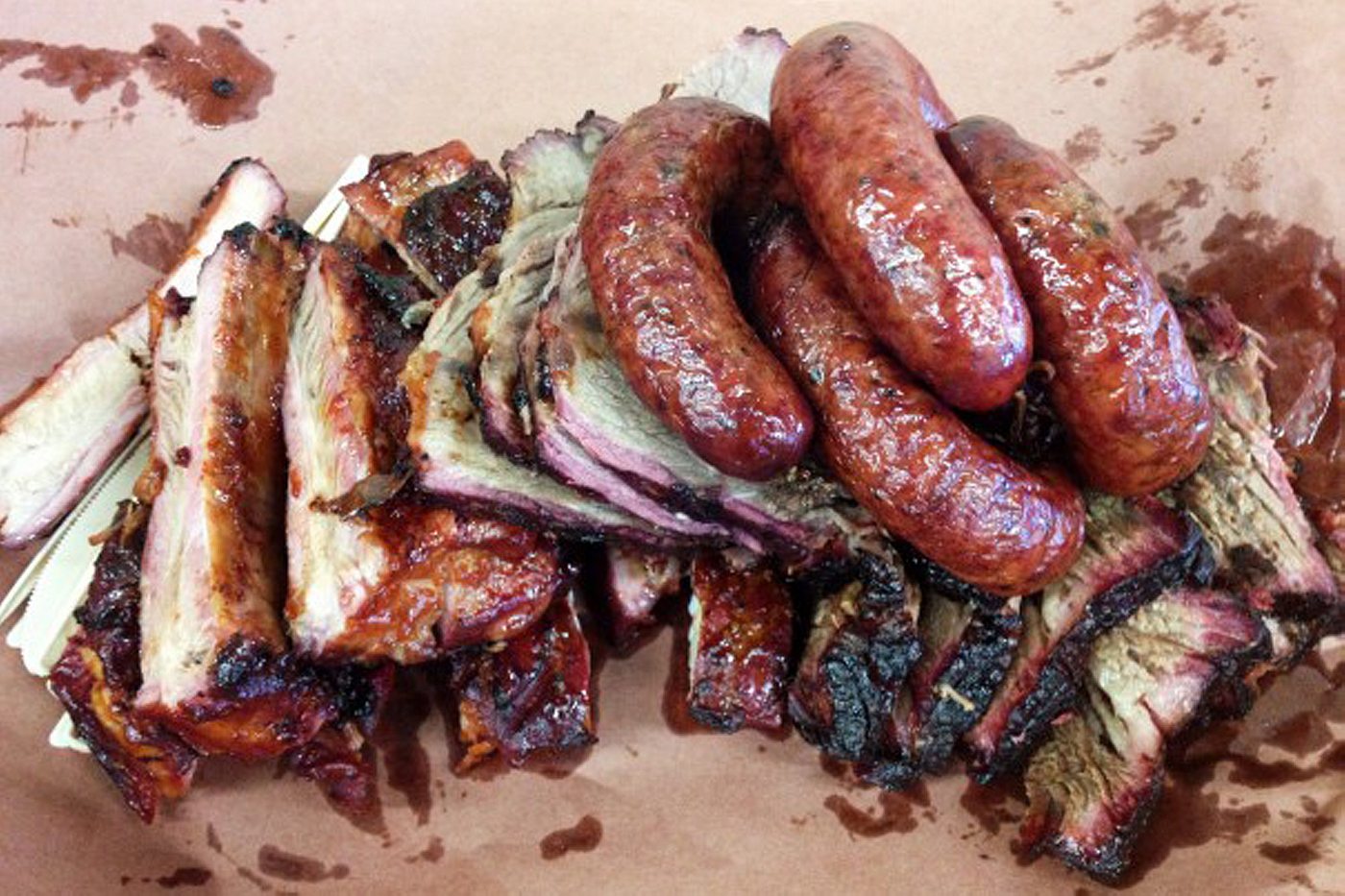
Brisket and Sausage
Smitty’s Market, Lockhart, Texas
Days after Roads & Kingdoms launched at South By Southwest in Austin, Nathan took a break from the hype-swamp to visit Lockhart, home of three of the most famous meat emporiums in Texas. After consuming a few pounds of smoked beef, and wishing his German ancestors were more eaters than drinkers (“Brisket Germans, not Beer Germans”), he boldly declared Smitty’s the Lockhart BBQ King.
I love the long hooded firepits of Kreuz, but Smitty’s actually makes all its customers tiptoe past an open
mesquitepost oak fire, as if to engender some sort of empathy or deeper connection to the brisket you’re about to eat. The customer is half-smoked by the time he or she reaches the counter. And in an age of liability laws and lawyerdom, an open fire without so much as a grate protecting all who come is itself a thing of beauty, a throwback. As is the Lockhart way of serving meat, bare on butcher paper, with a halfloaf of wonderbread and perhaps a block of cheddar. In our party, there were differing opinions about which part of this meatpile was the best. There were sausage devotionalists—I do believe Kelly Hines suggested making a necklace out of it and Matt Bean thought it would make a nice present for his girlfriend. This brisket, and its perfect balance of meat and fat, was my favorite; my daughter was likewise smitten. The ribs themselves won my wife over, because they are like ribs you might find elsewhere in creation, just better. Don’t ask for BBQ sauce at Smitty’s or for a fork: anything that would stand in the way of the intimacy between mouth, fingers, and beef is, as my people used to say, verboten.
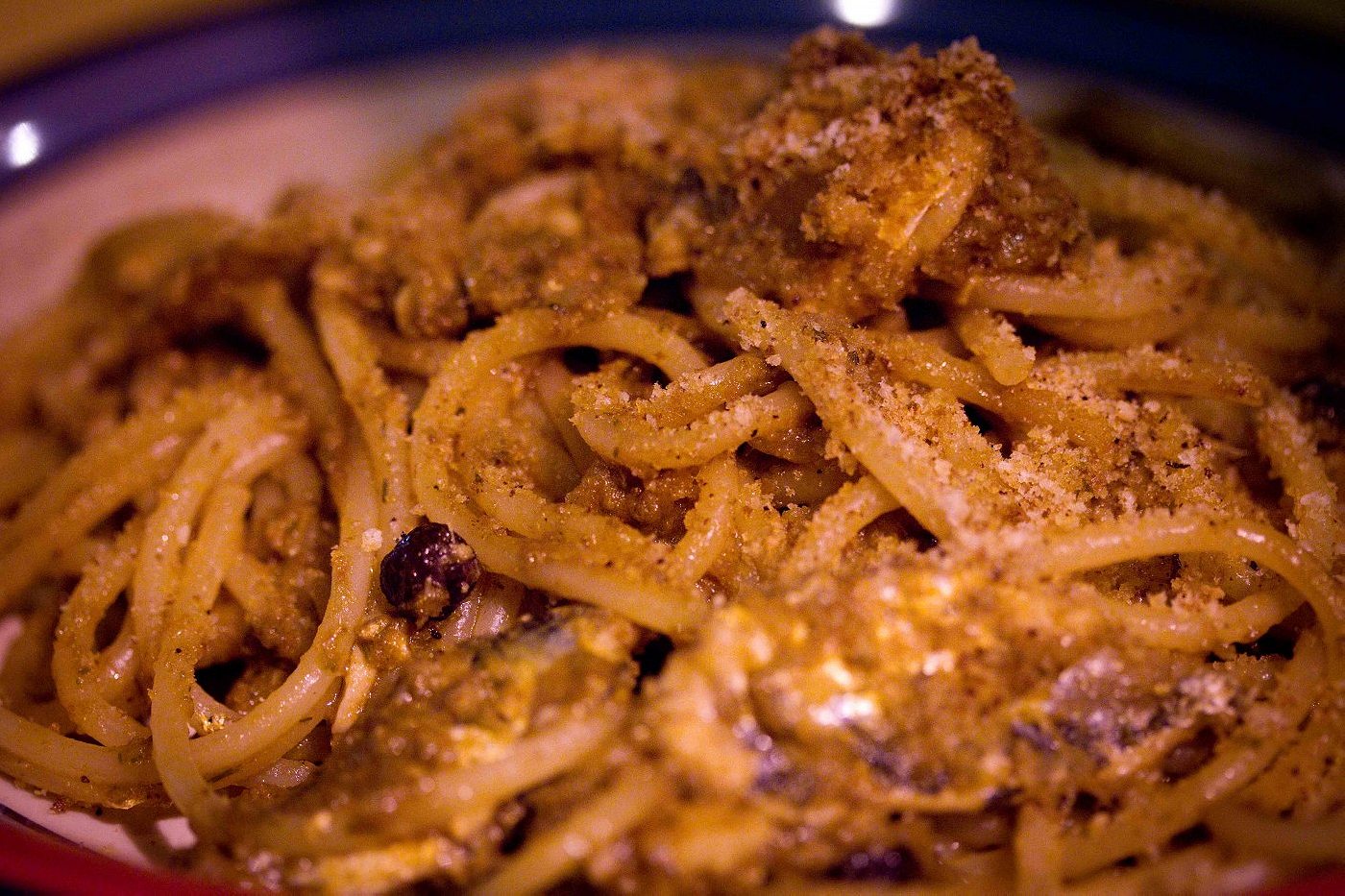
Pasta con le sarde
Trattoria Ferro di Cavallo, Palermo, Sicily
Sicily is the land of a thousand edible treasures: sea urchin spaghetti, breakfast ice cream sandwiches, tomatoes with the intensity of the Sicilian sun concentrated into their fire-truck flesh. After a week of carboloading across the island, we pulled into Palermo for a final feast before saying goodbye to the south of Italy. More than anywhere we ate on the trip, this little street corner trattoria revealed the beauty and the importance of Sicilian food.
The reason the trattoria is so important to Sicilians, though, has little to do with the food itself. It’s because meals here are meant to be stretched out over the course of hours, and the trattoria format—appetizers followed by pasta followed by a main course, all soaked in bottles of inexpensive wine—makes a marathon meal feel like a leisurely jog. One of the best meals I ate in Palermo was a three-hour bacchanalia with a pair of Sicilians at the bustling Ferro di Cavallo on Via Venezia. Waiters pressed glasses of prosecco into the palms of young Palermitani gathered out front. Streetlights cast a gentle glow over the sidewalk tables. Menus came printed directly on the tablecloths: 4€ for antipasti, 5€ for pasta, 7 € for meat and fish.
All of this could fall flat, feel too much like a caricature of a Sicilian trattoria, if the food itself wasn’t so damn good: arranciette, saffron-scented rice fried into crunchy, greaseless golf balls; polpette di pesce de spada, swordfish meatballs with a taste so deep and savory they might as well be made of dry-aged beef; and a superlative version of caponata, that ubiquitous Sicilian starter of eggplant, capers and various vegetation, stewed into a sweet and savory jam that you will want to smear on everything.
The pasta: even better. Chewy noodles tinted jet black with squid ink and tossed with sautéed rings and crispy legs of calamari—a sort of nose-to-tail homage to the island’s cherished cephalopod. And Palermo’s most famous dish, pasta con le sarde, a bulge of thick spaghetti strewn with wild fennel, capers, raisins, and, most critically, a half dozen plump sardines slow-cooked until they melt into a briny ocean ragu. Sweet, salty, fatty, funky—Palermo in a single bite.
And yet somehow, even with this lovely bounty before us, the food was overshadowed by the conversation at our table. As we plodded our way through the meal, Alessio Genovese, a Sicilian journalist from nearby Trapani, talked to us about Palermo’s immigration issues, about Sicily’s ambivalent relationship with the rest of Italy, about the micro-dialects and cuisines found all over the island. “You can move from one village to the next and find the food and the language have changed completely.”
Four times the server came by to pick up the plate of pasta and four times she was sent back empty handed—each time with an increasingly intense waggle from Genovese’s finger. The two Americans at the table, we had put our forks down an hour earlier, but the two Sicilians pushed forward, eating, drinking and talking in such a perfectly balanced manner that time seemed to stop moving altogether. The oil from a pasta, the last drops of wine, the final thought in a conversation: crumbs are precious in Palermo and they will be eaten, with the tines of a fork, the heel of a baguette, or the tip of an index finger.
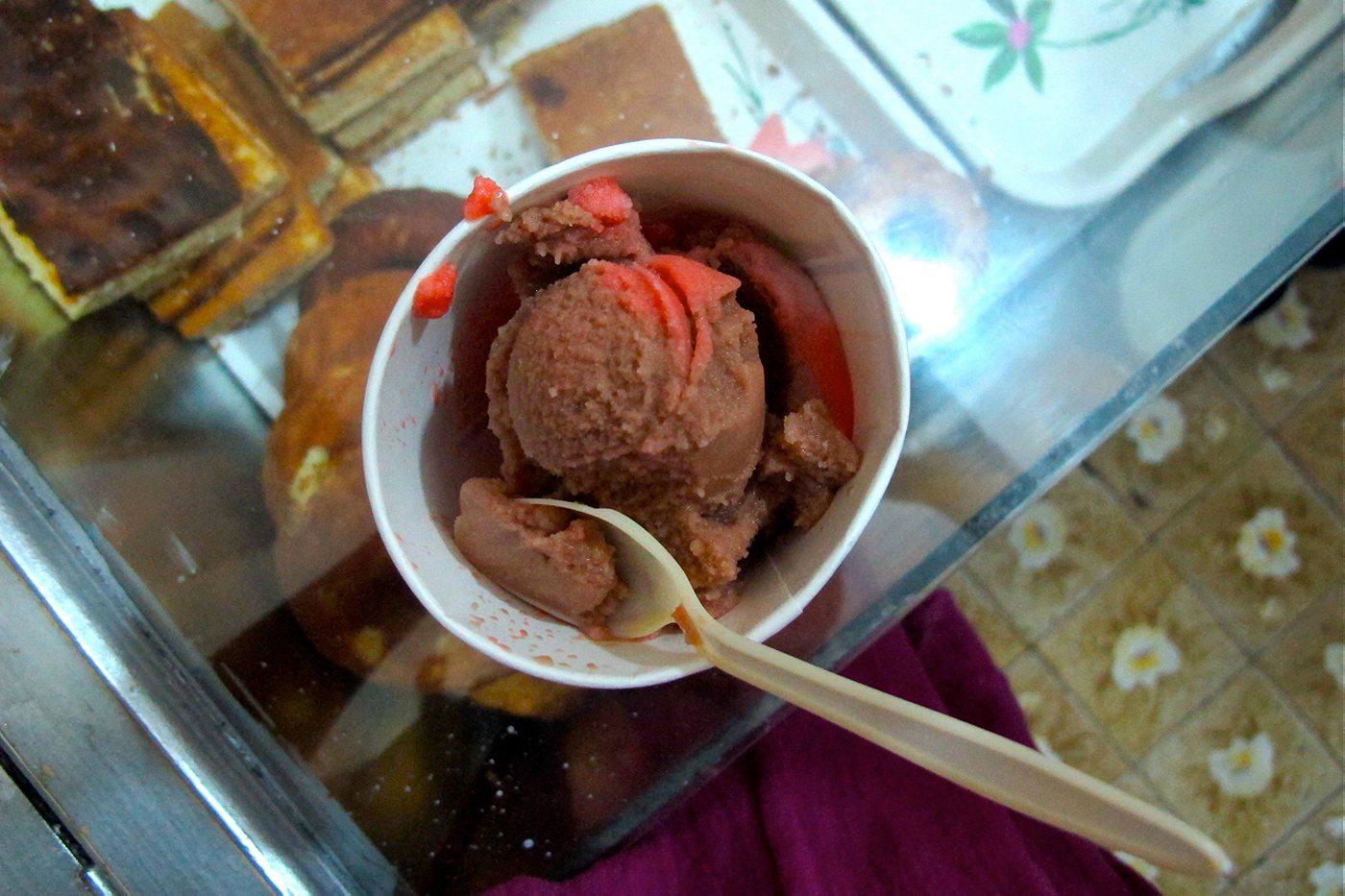
Chocolate ice cream
Sixa Ice Cream Parlour, Mogadishu, Somalia
And for dessert, how about a bit of ice cream? When R&K correspondents went in search of the best scoop in Somalia, Mogadishu mayor sent them out with a four-vehicle convoy, a truck-mounted anti-aircraft battery, twenty policemen, and the Somalian Minster of Intelligence. When asked for a slogan for his town, he proudly proclaimed, “No longer the most dangerous city on the world.”
The Sixa ice-cream parlour on 21 October Road is wallpapered with neatly stacked soda cans and bottled fruit juice in colour-coded perfection, garnished with supermarket tinsel.
The owner, Omar, has a slightly bucktoothed smile: shy, but proud. Omar’s Neapolitan ice cream is served in a paper cup, with printed depictions of juicy grapes, oranges and strawberries and a beige plastic spoon. The scoops heaped, one upon the other, the pale brown chocolate smooshed next to a strawberry reminiscent of boiled sweets.
Each mouthful sharply icy on the tongue, gently jarring on my front teeth, more milky frost than dairy. The colours meld unapologetically in the slight humidity. No matter. Chocolate, strawberry and vanilla—all verging on the almost-but-not-quite-too-sweet—are indistinguishable in their cardamom warmth.